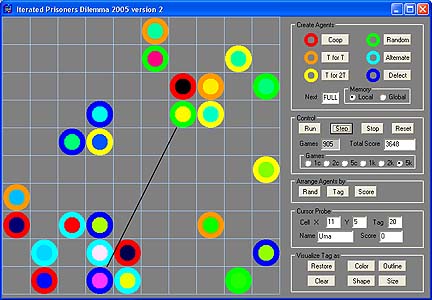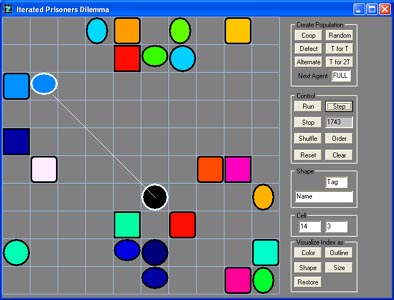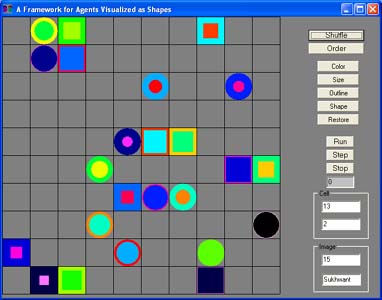Iterated
Prisoners' Dilemma - CodeGear C++ Builder 6 Applications
Two
suspects are apprehended after a bank robbery. We know they are both
involved but may have some difficulty proving their guilt. We take each
suspect to a different interrogation room and make each one an offer
to turn state's evidence. We say privately to each suspect,
"If you confess and implicate your partner before he confesses,
we will give you 5 years off your mandatory sentence. If he confesses
first then he gets 5 years off and you get no break on the time your
serve. If you both confess at the same time you each get only 1 year
off. If you both keep quiet, I'm afraid you'll each get 3 years off
since we'll have difficulty establishing your guilt."
So
if one prisoner "rats out" on the other, he gets a payoff
of 5 and the other gets 0. If both prisoners cooperate with one another
and say nothing, each gets a payoff of 3. If they both implicate each
other the both get a payoff of 1 apiece. The prisoners know the game.
What should they do?
The
games below assume a community of agents with different strategies for
playing the game, playing it with one another many times. The strategies
are always Cooperate, Tit-for-Tat (T for T), Tit-for-Two-Tats (T for
2T), random, alternate and always Defect.
|
|
|
2006 Evolutionary Iterated Prisoners
Dilemma
An evolutionary enhanced version of the classic game.
Evolution is achieved by randomly changing the strategy of the worst player
every 100 games.
Devolution is achieved by randomly changing the strategy of the best player
every 100 games.
Evolution changes the screen to a pale green.
Devolution changes the screen to a pale pink.
A high not is played when an evolutionary change is made. A lower note
is played when a devolutionary change is made.
|
Iterated Prisoners Dilemma -
2006
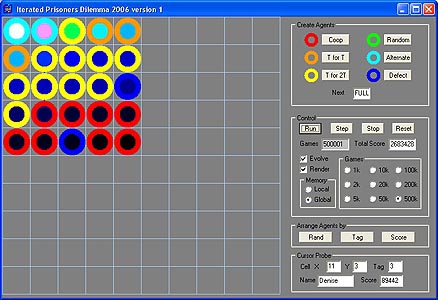
An
evolution option has been included, which selects a random strategy
for the poorest player every 100 iterations.
An
option to turn off rendering has also been included so that experiments
may be run more quickly.
Games
will now run up to a maximum of 500,000 iterations. At that setting,
on average, each player will play 20,000 times and play each other player
800 times.
Alternative visualization
options have been deleted.
To do: Show the population
of each strategy through time.
|
|
Payoff
Matrix
|
Cooperate
|
Defect
|
|
Cooperate
|
3,
3
|
5,
0
|
|
Defect
|
0,
5
|
1,
1
|
|
With a beginning
ratio of 4:4:4:4:4:6
run through 500,000 iterations with evolution.
|
|
|
Local Memory
|
Global Memory
|
|
Run 1
|
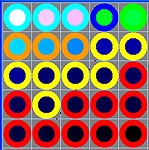
Total Score = 2783941 |
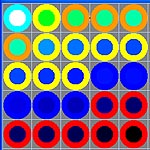
Total Score = 2386013 |
|
Run 2
|
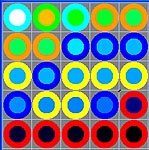
Total Score = 2244088 |
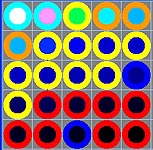
Total Score = 2683428 |
Is this system sensitive to initial
conditions? Try setting the first population to all Cooperators or all
Defectors. Is there any difference in the outcome?
|
|
|
Garret's Evolutionary Iterated
Prisoners Dilemma
An evolutionary enhanced version of the classic game.
This version will not work without Borland installed.
|
|
|
Iterated Prisoners Dilemma - 2005
One of six strategies may be selected for each of
25 agents and agents may use either local or global memories. Strategies
are visualized by the outline color while individual scores are represented
by the interior. Circles have popup boxes giving details of each agent.
Shapes may be randomly placed or rearranged and may be moved by clicking
on them and then clicking on an empty square. An array of shape objects
is utilized.
|
Payoff
Matrix
|
Cooperate
|
Defect
|
|
Cooperate
|
3,
3
|
5,
0
|
|
Defect
|
0,
5
|
1,
1
|
|
|
|
Iterated Prisoners Dilemma - 2004
One of six strategies may be selected for each of
24 agents. Strategies are visualized by the shape of the representation
while individual scores are represented along a color spectrum. Shapes
have popup boxes giving details of each agent. Shapes may be randomly
placed or ordered and may be moved by clicking on them and then clicking
on an empty square. An array of shape objects is utilized.
|
Payoff
Matrix
|
Cooperate
|
Defect
|
|
Cooperate
|
3,
3
|
5,
0
|
|
Defect
|
0,
5
|
1,
1
|
|
|
|
Agents as Shapes
A Visualization Framework for Iterated Prisoners'Dilemma
This is the visualization "shell" for a
simulation of Iterated Prisoners' Dilemma. Shapes are used to visualize
24 agents in a world array of 10 by 10. Mousing over the shapes or the
cells will display the correct agent and array indices, respectively.
Clicking on an shape, then clicking on the screen will move that shape
and its underlaying agent to a new position on the screen and in the array.
The simulation code
has not been written, so Run, Step and Stop have no content.
|
Payoff
Matrix
|
Cooperate
|
Defect
|
|
Cooperate
|
3,
3
|
5,
0
|
|
Defect
|
0,
5
|
1,
1
|
|
|
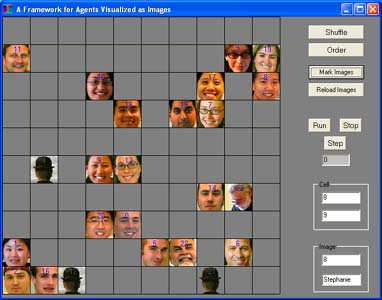
|
Agents as Images
A Visualization for Iterated Prisoners'Dilemma
24 images are used to visualize 24 agents in a world
array of 10 by 10. Mousing over the images or the cells will display the
correct agent and array indices, respectively. Clicking on an image, then
clicking on the screen will move that image and its underlaying agent
to a new position on the screen and in the array.
The simulation code
has not been written, so Run, Step and Stop have no content. The executable
will not run unless it is in the same folder as ALL the images. So save
all these to the same file before running the application.
|
Payoff
Matrix
|
Cooperate
|
Defect
|
|
Cooperate
|
3,
3
|
5,
0
|
|
Defect
|
0,
5
|
1,
1
|
|


